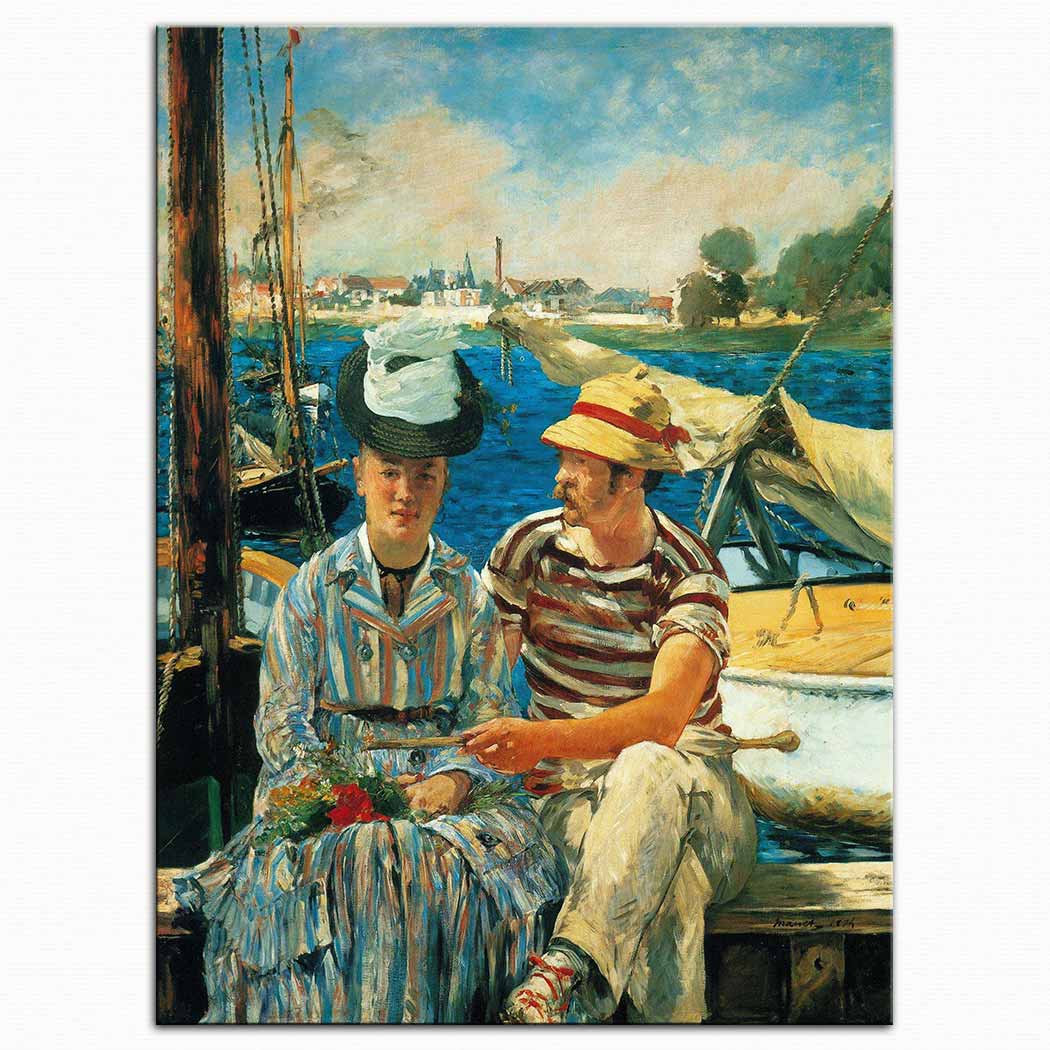

The sail at right is rendered at an odd angle, leaving the subject of the sitters’ activity barely cropped into view.

The artist worked to unify the composition through both color and line in these ways. While the black ribbon on her hat at left runs parallel to the sail’s sheet at right, the blue-green ribbon on his hat as well as the blues of her dress echo the various blues of the water that dominate the image. The netting on her hat could keep away such possible intrusions from outdoor life as river water and dust, then believed to be harmful to one’s health (see Marni Kessler, Sheer Presence: The Veil in Manet’s Paris, Minneapolis, 2006). More specifically, his white shirt, white flannel trousers, and straw boater with a blue border have been identified as the uniform of the tony Cercle nautique boating club, headquartered in Asnières (Herbert 1988). The male and female boaters in The Met’s picture are out to "see and be seen" in the new casual dress favored for such sporty outings, a jaunty white boating outfit with a straw hat for him and a maritime blue-striped dress with a white hat for her. (It is now owned by the Musée d’Orsay in Paris.) More recently, curators such as Denise Murrell have relied on the painting to consider how race was represented by 19th-century European artists.The Painting: In the summer of 1874, Edouard Manet painted this ode to the relatively new bourgeois and upper class Parisian leisure activity, boating on the Seine, when he was living at his family’s property in Gennevilliers across the river from Claude Monet and Auguste Renoir in Argenteuil (both communes northwest of Paris). The painting was deemed offensive on its debut, though his friend Monet eventually convinced curators to display it at the Musée du Luxembourg. Manet again eschews the Renaissance tradition of smooth blending in favor of quick brushstrokes and harsh lighting, which further humanizes the subject.

Using Titian’s Venus of Urbino as a reference, Manet painted a number of details which signified the woman as a sex worker: the decorative slippers, the orchid tucked behind her ear, her bracelet and pearls, and the proffered bouquet, which can be interpreted as a gift from her patron. The painting features a nude woman (the same model as Luncheon, Victorine Meurent) splayed across a bed while a servant attends to her. Manet’s Olympia was accepted by the Salon of 1865, where it provoked harsh criticism. Universal History Archive/UIG/Shutterstock Olympia, 1863 Below, a guide to some of the most famous works by one of the fathers of European modernism. Manet would be heartened to know that today his paintings sell upward of $65 million. Someone must be wrong,” the artist once wrote in a letter to his friend, French poet Charles Pierre Baudelaire who, with writer Émile Zola, was among Manet’s most ardent champions. Unfortunately it took most of his life for his own paintings to achieve critical or financial success he died on April 30, 1883, one year after his painting A Bar at the Folies-Bergère debuted to mixed reviews at the Salon. “They are raining insults on me. There, he sketched artworks in the Louvre (where he met Edgar Degas), finding inspiration in Gustave Courbet’s rejection of Romanticism and Diego Velázquez’s baroque colors. To their disappointment, Manet failed the training entrance exam twice as a teenager, and was finally allowed to enroll in art school in Paris. Manet was born into an upper-class family that envisioned for him a life of military service or law-his father was an official in the French Ministry of Justice, his mother, the goddaughter of the Swedish crown prince. Previously Unseen Parts of Manet's Eva Gonzalès Portrait Come to Light During X-Ray Analysis


 0 kommentar(er)
0 kommentar(er)
